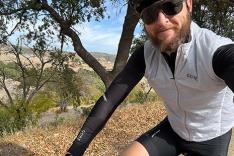A Word About Hand Positions
Some indoor cycling programs will dictate where and when you should put your hands on the handlebars. Ignore these requirements for the most part and put your hands where you are most comfortable, changing them often and keeping in mind the reasons you put them where you do on your bike outside.
For example, when you stand up, you most likely move them to the outsides of the bars for stability and leverage. Do the same indoors—it's uncomfortable and ineffective to keep them on the tops of the bars in a standing position. Refrain from holding the hands in the center of the bars at any time, or holding them in any type of prayer position.
There is a lot of real estate on the bars on indoor bicycles, for the simple reason that the bikes are designed for riders of many different sizes. When seated, if you are tall with long arms, you may be able to comfortably slide your hands forward on the bars, almost to the bar ends. On the other hand, if you have short arms or a short trunk, then you wouldn't want to slide your hands near the bar ends while seated—it would be like riding a bike that is two sizes too big for you and would cause stress in the neck and shoulders.
Instead, put your hand on the handlebars so that you maintain a 90-degree angle at the shoulder joint. Stretching forward greatly increases that angle. When standing with a lot of resistance (climbing), move the hands to the bar ends as if on the hoods of your own brake levers.
The aero position is not recommended for anyone on any type of indoor cycling bicycle, triathlete or not, and regardless of whether the instructor says to do so or not. These bikes are not your expensive, perfectly-fit road bikes. They are also not the same geometry of a triathlon or time trial bike, so an aero position will potentially do more damage than good. If you are a triathlete and need to practice the aero position, do it on your trainer at home.
A Word About Intensity
Indoor cycling classes often tend to be pedal-to-the-metal in every class, every week of the year. I recommend working all aspects of your cycling fitness, including the range of intensity parameters that are outlined in the list above. Periodize your program, starting with easier workouts in the early winter and then gradually increasing intensity throughout the winter months. Alternate harder days with easier days, and higher cadence, lower gear workouts with higher resistance climbing workouts.
When it's time to go hard, classes are a fantastic place to give it your all, perhaps even more so than alone on your trainer. But if your own training program calls for an easier workout than the instructor has planned, stick to your own plan and try not to get caught up in the energy of the class and go harder than you are supposed to. Wearing a heart rate monitor can help you stay honest with your planned workout.
In summary, when deciding whether to do a movement in an indoor cycling class, ask yourself if it would inhibit power output and performance outdoors, or your ability to ride your bike properly. If so, then it will do the same indoors and you should not do it. If it would likely injure or cause discomfort in a cyclist on a road bike, then it will likely injure or cause discomfort indoors too. It's that simple. Embrace the wonderful benefits of indoor cycling classes and remember to Keep it real.
Just ride the bike!
Jennifer Sage has been in the fitness industry for 30 years, and is a certified personal trainer, a certified strength and conditioning specialist, a cycling coach and she has a degree in exercise science. She has been a fitness presenter all over North America for 15 years, including 12 years as one of the top Master Instructors for the Spinning? program, certifying instructors, creating workshops and presenting at conferences. In 2011, she founded the Indoor Cycling Association, which has quickly become the premier online educational resource for indoor cycling instructors.
In 2008 she wrote the eBook called Keep it Real, which is targeted at cyclists to teach them how to utilize indoor cycling classes in order to maximize their training time.
- 4
- of
- 4








Discuss This Article